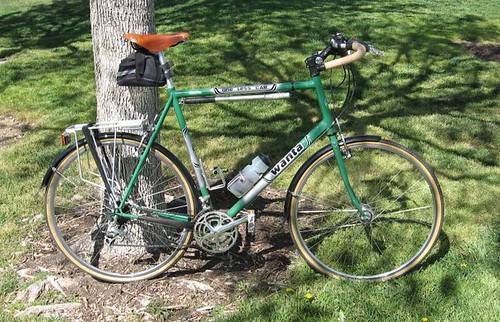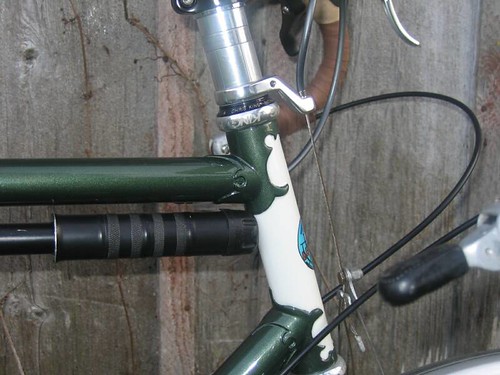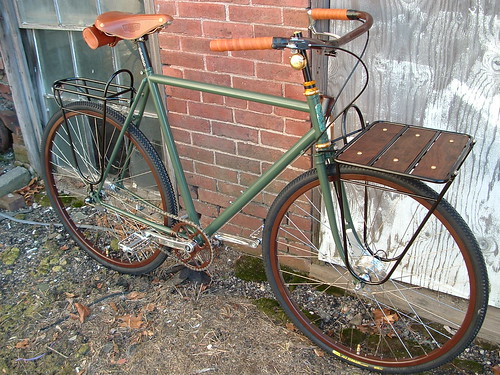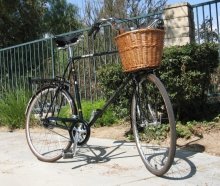
Finding and Buying the Right Bike
This article focuses on helping folks find a good, reliable commuter bicycle for a reasonable price. A good commuter can take lots of forms. All the “cool kids” are riding road bikes these days, and road bikes can make great commuters. However, all terrain bikes (ATBs) make great commuters as well, and since they are not currently in fashion, they tend to cost less. Generally speaking, ATBs offer a more upright seating position which is comfortable and provides for a good, heads-up viewpoint. They also have very durable wheels, frames and components.
Road bikes, on the other hand, are more efficient and faster. The “drop” handlebars on road bikes provide multiple hand positions, which can help riders avoid wrist, hand and shoulder pain over long rides. Road bikes designed purely for racing tend to be too fragile for most commuting duties, but most road bikes were designed to be sturdy enough for “real world” use. These benefits make road bikes a great choice for commutes longer than 10 miles or so, while ATBs shine on shorter rides. “Hybrids” or “City Bikes” provide another option. With sitting position similar to that of an ATB and wheels which are halfway between road and ATB wheels, these bikes provide many of advantages of an ATB without as much of an efficiency penalty.
For most commuters, the overall quality of a bicycle is more important than the style. An ATB with narrow, high pressure tires and “bar end” handlebar extensions will feel a lot like a road bike and give the rider multiple hand positions. A road bike with fatter tires and sturdy rims will be plenty rugged for the streets of most urban areas. A buyer who is willing to consider ATBs, hybrids and road bikes is likely to get the best deal on a great bike.
The quality of a bicycle is linked to the brand of the bicycle. The best brands have always been sold through bicycle shops. Companies such as Trek, Specialized and Cannondale have produced wonderful bikes for decades, and they tend to hold their value very well. Other brands also produce (or produced) great bikes but are not as well known. Old bikes from Univega, Nishiki, Scott, GT, Kona and Bridgestone all started life as high-quality products, but are often sold at bargain-basement prices. There are many other good brands as well. If you see a bike that looks intriguing, do a web search on the brand name to see what the experts say. Or better yet, find an expert and ask him/her about the bike.
Bikes originally sold by department stores should be avoided by people looking for reliable transportation. Brands to avoid in this category include Huffy, Murray, Magna and Pacific. Most Free Spirit brand bikes from Sears also fall into this category.
Schwinn has made some good bikes, some great bikes, and some horrid bikes. Schwinns built up until the mid-1970s tend to be heavy, but bomb-proof. Schwinns from the mid-1970s through the 1990s were good quality machines. Schwinns made in the last few years were sold at big box stores such as Walmart and should be avoided. Fortunately, Schwinns have a large and enthusiastic fan base, so there is a wealth of information on the nameplate available on the web. If you find a Schwinn you like, do a web search on the model name and see what comes up.
Quality sometimes depends on price as well. Expect to pay at least $50 for a decent fixer upper which will require another $50 to $150 in parts and repair work. For $100 to $250, a buyer can purchase a good, solid bike which will not require many new parts, but will probably need a good tune up. If you have more than $250 available for a used bike, you can get a wonderful, high-performance machine or a collectable classic, or both! Once again, the bicycle may need a professional tune up, but after that the bicycle should be a pure joy to ride.
 Another important consideration is the size of the bicycle’s frame. No matter how good a bicycle is on paper, if it does not fit you, riding it will be a miserable experience. When looking at bicycles, stand over the “top tube,” the bar the connects the seat area to the handlebar area, with both feet flat on the ground. On a road bike, you should have about an inch of clearance to the tube. On a mountain bike, you should have between two and four inches of clearance. While the length of your upper body relative to your legs can effect the frame size you should choose, the general frame sizes people of average build should ride are listed in the table, below. To find the frame size, measure from the middle of the crankset (the parts that connect the pedals to the frame) to the top of the top tube.
Another important consideration is the size of the bicycle’s frame. No matter how good a bicycle is on paper, if it does not fit you, riding it will be a miserable experience. When looking at bicycles, stand over the “top tube,” the bar the connects the seat area to the handlebar area, with both feet flat on the ground. On a road bike, you should have about an inch of clearance to the tube. On a mountain bike, you should have between two and four inches of clearance. While the length of your upper body relative to your legs can effect the frame size you should choose, the general frame sizes people of average build should ride are listed in the table, below. To find the frame size, measure from the middle of the crankset (the parts that connect the pedals to the frame) to the top of the top tube. When looking at any type of bike, check a few important areas:
When looking at any type of bike, check a few important areas:• Make sure that the frame and fork are not bent or heavily dented
• Look for rust on the chain, spokes and frame
• Lift the bike up and spin both wheels. The rims should not wobble from side to side or jump up and down
• Ride the bike and make sure that the gears shift well and the brakes stop you in a controlled manner
• Check the tires to see if they are dried and cracked
If you see damage to the frame or fork, walk away. If you find problems in any of the other areas listed above, you can fix them, but it will cost you. Cleaning and lubing a mildly rusty chain or installing new inner tubes is easy and inexpensive. On the other hand, replacing an entire wheel’s worth of rusted spokes or buying a high-end derailleur can cost more than a cheap used bike. Use your judgment, but understand that a few repairs can add up to a substantial amount of money. If there is something about the bike that makes it impossible to test ride, you should probably walk away.
 Avoiding Scams and Ripoffs
Avoiding Scams and RipoffsUnfortunately, craigslist attracts unscrupulous folks who are looking to profit from other people’s ignorance. Use common sense at all times. If a deal seems too good to be true, it probably is. When shopping for a bicycle, follow these simple guidelines:
• The more superlatives in the ad title, the worse the deal. Phrases like “Won’t Last!” “Incredible Deal!” and “Ultra High Performance Olympic Quality Bike for Less Than $500!” are all signs of trouble. When someone tries to hype a bicycle so much, it almost always means the seller is looking for an ignorant buyer.
• If you see the same ad popping up over and over again, ignore it. Craigslist only allows a person to post the same ad once each week. If the same ad keeps popping up every day, the seller is cheating the system to get more exposure. If the bicycle were worth the asking price, it would sell without multiple postings.
• Do not buy new bicycles from businesses. Craigslist was created for individuals to sell used stuff to other individuals. There are rules in place to keep businesses sequestered in one area of craigslist, where they pay for their ads. Any ads showing lots of new bikes for sale in the “Bicycles for Sale” section were posted by sleazy sellers. Most such ads are for beach cruisers costing less than $100. These bicycles are junk.
• If you send questions to a seller and don’t get straight answers or get a response that pressures you to buy right away, look for another bicycle. There are lots and lots of bikes for sale on craigslist. If you miss out on one, another great one will pop up in a little while.
If you see a bike that looks interesting, but you are not sure if it is the right bicycle for you, ask an expert. Most people have at least one friend who is a bike nut. If you do not, you can walk into a bike shop and ask an employee. He/she will understand that if you buy a used bike, you may soon be looking for someone to service it, so he/she should be motivated to help. Finally, you can post your questions on any number of internet-based lists such as:
• http://sports.groups.yahoo.com/group/Bicycle_Restoration
• http://bikeforums.net/
• http://forums.roadbikereview.com
After You’ve Made the Purchase
 If you follow the guidelines listed above, you should find a wonderful bicycle in a few weeks or a month. However, as mentioned above, your bike will probably need some mechanical work and perhaps some new parts to restore it to its former glory. Most bikes purchased from craigslist need a tune-up or even a complete overhaul. Rubber parts such as tires, tubes and grips often need to be replaced. Chains and “gears” (freewheels or cassettes) wear out and rust. If you do not have much mechanical experience, you should take your bicycle to a local bike shop and have them perform the necessary maintenance work.
If you follow the guidelines listed above, you should find a wonderful bicycle in a few weeks or a month. However, as mentioned above, your bike will probably need some mechanical work and perhaps some new parts to restore it to its former glory. Most bikes purchased from craigslist need a tune-up or even a complete overhaul. Rubber parts such as tires, tubes and grips often need to be replaced. Chains and “gears” (freewheels or cassettes) wear out and rust. If you do not have much mechanical experience, you should take your bicycle to a local bike shop and have them perform the necessary maintenance work.If you have the motivation but not the tools, there are many community bicycle organizations that are set up to provide tools and instruction to folks who want to repair their own bicycles. These places are staffed by knowledgeable volunteers who will answer your mechanical questions and offer other help. Some also offer classes in bicycle repair. A list of such organizations can be found on the bikecollectives.org website.
If you are truly adventurous, you can repair any bike on your own. There are many great books available on bicycle repair and maintenance from bookstores, bicycle shops and the library.










